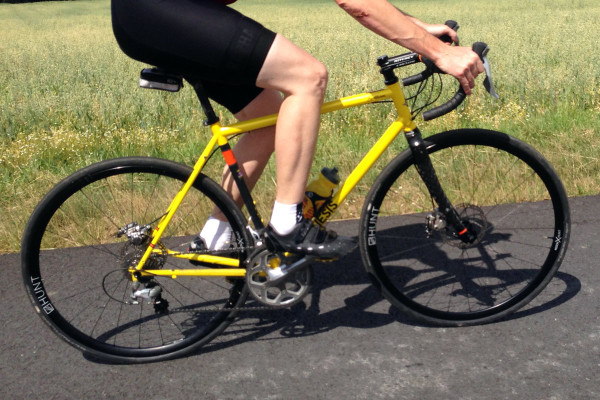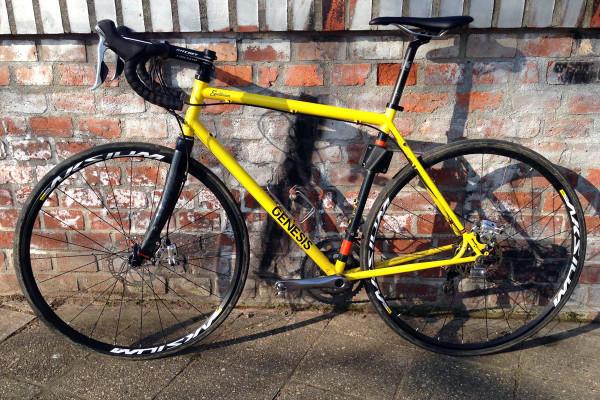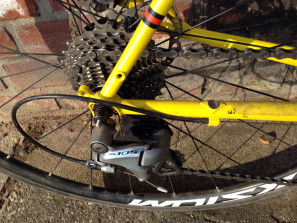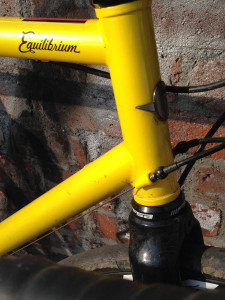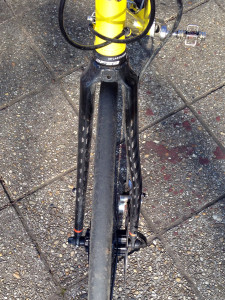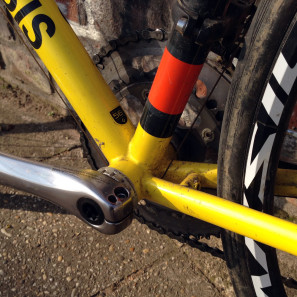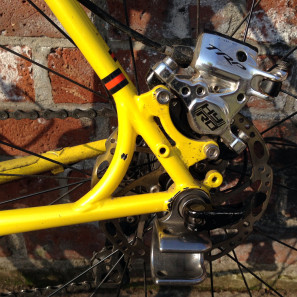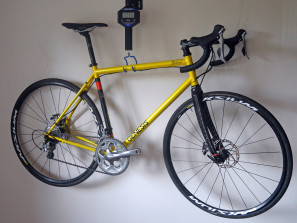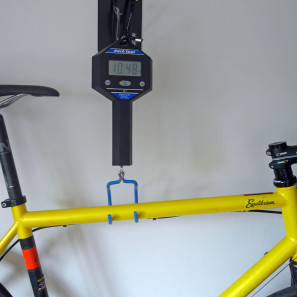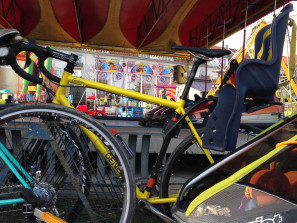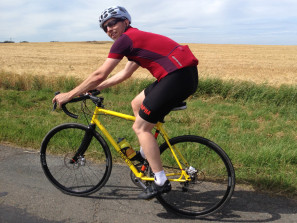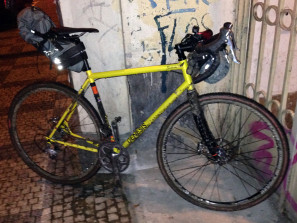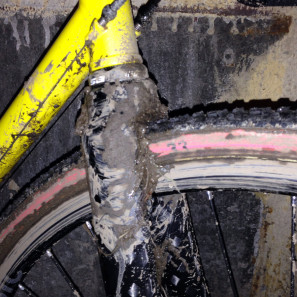From our European base of operations in the Czech Republic we have a bit of an affinity for steel road and cross bikes, maybe even at times to a fault. But dealing with regular travel, rough European roads, mixed riding surfaces, and never being all that concerned whether we finish first or just off the podium, having a bike that can take a lot of abuse and still deliver a good ride quality takes precedent. So while riding the latest plastic wonder-bike is always nice, we love to spend long days in the saddle on more everyman’s bikes cruising quiet roads and wandering off onto dirt and gravel tracks.
And the Genesis Equilibrium Disc 20 is a perfect bike for that. It has a bit of back country roads in its genes (or rather its UK steel tubes.) We’ve spent the better part of a year with this bike in our test line-up, and while it was never the fastest or lightest bike we rode, it was very likely the most versatile, and definitely the one we devoted the least time to cleaning. As a result it probably got the most saddle time of any single test bike over the last year. Come past the break with us to see why…
The bike is made by UK practical bike specialists Genesis Bikes. While they don’t deal exclusively in steel bikes, it is primarily what they are known for and probably their strongest suit. Pretty much all of the bikes they make are designed to be a pleasure to ride and go fast, but also serve day-in and day-out, whether as daily commuters, occasionally towing the family around, or simply tossing on a set of full coverage fenders to stick it out through the winter. The Equilibrium Disc 20 fits this bill pretty well. It was as happy to cart us back and forth to the office, as it was to strap on a kid seat and a Chariot trailer, and still be ready for a long day out exploring gravel and asphalt.
The 2015 Equilibrium Disc 20 that we’ve had on test is built with a seamless heat-treated Reynolds 725 double butted Cro-Mo tubeset. It uses a nice mix of TIG-welded construction with nicely detailed braze-ons for everything from external mechanical drivetrains, internal Di2 wiring, and both a rear rack and front and rear fenders. The tubing also strikes a nice aesthetic balance of modern oversize road diameters, matched to a machined, straight headtube, that gives the bike a thin classic look while providing modern performance.
An aluminum-steerered, tapered-leg carbon fork does a bit to disrupt the classic look (if only from front, where its asymmetry is most striking), but lends a bit of stiffness for predictable handling. To accommodate the larger front rotor, the non-driveside leg rises straight up from the dropout for clearance, and then bends dramatically to come back in line. While it was oddly distracting to see at first while riding the bike, the ride quality did not seem to be affected in any noticeable way.
From a details stand point, the Equilibrium Disc uses a standard press-in 1.125″ headset, a traditional 68mm threaded bottom bracket, straight tapered chainstays and seatstays, external downtube shift routing, a clamp-on front derailleur, a seatstay mounted IS disc brake tab with a strut in between the stays, and hooded dropouts.
The Equilibrium Disc 20 features an 11spd Shimano 105 drivetrain with a mid-compact 52/36 crank and an 11-28 cassette. The 105 brake levers pair with a set of TRP HyRd mechanical-to-hydraulic brakes with a 160mm front rotor and a 14o in the back. Wheels are Mavic’s new Askium One Disc with straight pull spokes and a 17mm inside rim width. The complete stock bike weighed in at 10.48kg (23.1lb) for the 56cm bike we had on test.
The £1500 Equilibrium Disc 20 is somewhat in the middle of Genesis’ road disc offerings. The cheaper version opts for a generic steel to save money, while the next model up shares the same 725 frame but with a higher component spec. Then, at the top there is a titanium version that shaves about a half kilo (1lb) of the frame weight but almost doubles the price.
Long Term Thoughts
In the last year of riding, the Equilibrium was really the most versatile road or cross bike we’ve had in that time. It has the comfortable, even forgiving ride that we’ve come to expect from a quality steel bike. It was in no way a snappy accelerator, so we didn’t win even any town line sprints on the bike. We also didn’t set any KOMs on the Equilibrium. But what we did was ride the bike a lot. Whenever the weather was bad or it was windy, we hit the road with this bright yellow bike, and rode everything from city cobbles to hard packed singletrack, often on the same ‘road’ ride.
The Askium wheels are surprisingly heavy at 1974g, so they definitely didn’t give the bike a sprightly air, but rather had a stiff bombproof feel to them. We swapped in a set of Hunt 4Season disc wheels this summer for longer road riding and that dropped about 400g for the pair, plus another 50g a wheel for their light tubeless tire setup. The difference in the ride was enough that I started to turn 2 hour rides into 4 hour ones. The bike really benefits from a light wheelset, and once the Hunt wheels went on we never looked back to the Mavics.
Regarding the other components, it’s hard to ignore the 105 groupset. With the new 11 speed group, and especially the long-armed front derailleur, shifting and overall drivetrain performance was excellent, throughout the test. While there is weight to be saved in the upper groups, there really isn’t much better performance until you go Di2. The TRP brakes do their job, and do automatically adjust which is nice for a cable actuated brake, but we never really were that happy with their performance. They just aren’t truly in the same league as the recent hydraulics from Shimano for power, and the smaller rotor in the back and the use of mid-level rotors just reinforces that. Stopping power was there and modulation was good, but they required a lot of effort at the brake lever compared to proper hydraulics.
The bike itself, though was ready for anything. Just to test out its limits, we even dropped some proper cross wheels in on occasion. While the bike certainly doesn’t sell itself as a knobby tired bike, we fit more than one pair of cyclocross tubulars in the frame and fork with 33mm cross tires and a few millimeters to spare. A premium cross tubular does wonders for ride feel, and this was no exception. While an unexpected muddy field slowed me down on one such nighttime adventure, the frame and fork took it in stride, clearing the mud surprisingly well. After playing around a bit with tires and wheels, we found that regular 28 and 30mm road tires fit a bit better, and probably best suit the roaming character of this bike best.
As our test comes to and end, I’m a little reluctant to ship the Equilibrium back home to the UK. It is definitely the kind of bike that I’d be happy to ride into the office everyday, sneak off for a quick spin at the end of the day, and then take it out on an adventure hunting new gravel roads for the weekend. Strap some bikebacking bags on like the Apiduras, and it is ready for an adventure. If that type of riding and wandering sounds nice, this bike may be worth a closer look.
